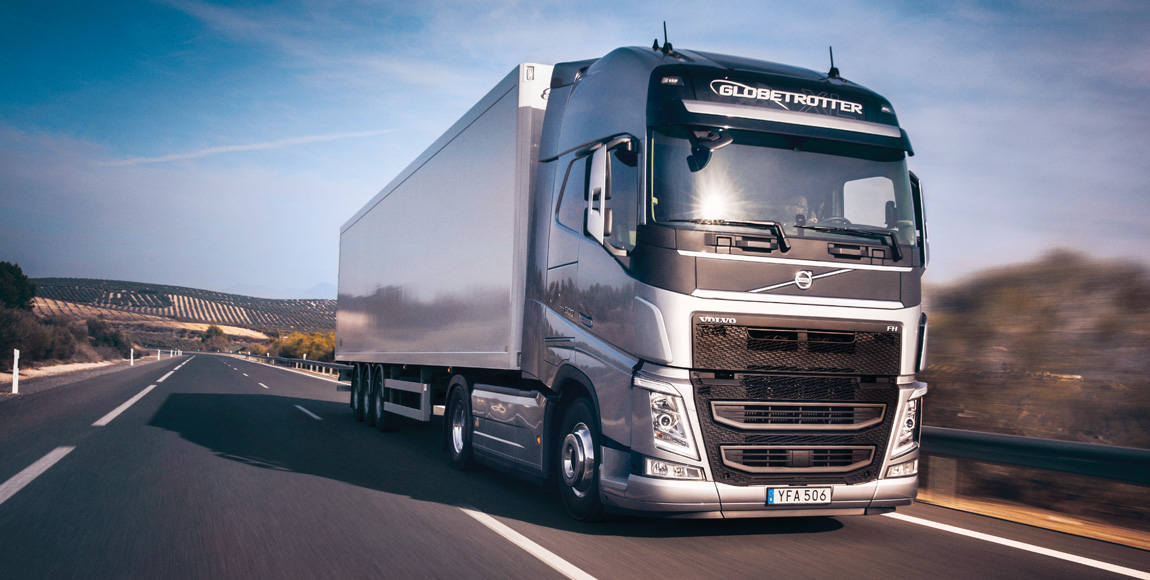It’s all in the “I” systems at Volvo Trucks

Volvo Trucks is adding another name to its suite of “I” systems. PAUL WHITE travelled to the company’s hometown of Gothenburg to find out what benefits the new I-Save system offers operators
It began with Volvo Trucks naming its somewhat revolutionary transmission I-Shift. Since then we have seen a number of improvements to the Swedish manufacturer’s trucks with systems such as I-See, I-Roll and I-Cruise. Now Volvo Trucks is adding another name to its suite of “I” systems, with the name I-Save. Opening the press conference, Tobias Bergman, director of press testing, stated that the new D13 turbo compound (TC) engine and the other software updates have resulted in “our most efficient truck ever”, adding that these systems when combined can achieve a seven-percent fuel saving in long-haul operations.
Volvo Trucks, like all manufacturers, defines long-haul as trucks as those that drive in excess of 125 000 km per year. It’s a highly important segment to the company as it makes up 70 percent of Volvo Truck sales.
Apart from the enhanced software programs, the new D13TC engine from Volvo Trucks comes with a number of clever innovations, such as its new patented “Wave” piston crown that guides the air back towards the centre of the piston to improve fuel scavenging.
Of course, the main feature is the idea to apply turbo compounding to the six cylinder. The D13’s turbo compounding is far from being a new system, but has a somewhat chequered history. However, Volvo believes it has resolved any issues and is fully confident it will deliver on the D13TC.
Turbo compounding for the D13TC operates by positioning an additional turbine after the regular turbocharger. The additional turbine reuses the excess energy from the exhaust gases, delivering this energy in additional torque to the crankshaft through a small gearing device.

The result of this is to increase the available torque of both the 460 and 500 hp (343 and 373 kW) versions by 300 Nm – a significant figure. The green band now begins at 900 and extends to 1 300 rpm. During the turbo compounding process, the exhaust gases are cooled by means of an exhaust-gas recirculating system; this cooling offers a benefit of a decrease in AdBlue usage of around five percent.
Matching Volvo’s new TC technology to the newly enhanced I-Shift and dual-clutch transmissions alters the driveline characteristics. The driveline has been further improved with a new efficient rear-axle offering from Volvo Trucks. The new axles introduce a lower pinion offset, high-efficiency bearings, and a reduction in oil volume. In addition, Volvo offers new efficient axles with ratios of 2.31:1 and 2.85:1.
On arriving at the test site, we were scheduled to drive two seemingly identical FH 500s. However, one of the trucks was fitted with the new D13TC engine and the full I-Save software, and the other (driven first) was the non-TC FH. This truck was as familiar as any FH driven previously with a dual-clutch transmission fitted with I-See and I-Roll.
The second drive in the FH with the new D13TC required some slight changes to our driving style, with even less work to do. Instructed by Tobias Bergman to “just let the truck do the work”, we duly complied. Not being quite sure how much difference the turbo compounding would make to the FH 500’s performance, in truth, we did not expect the difference to be in any way dramatic. Nevertheless, the contrast in performance between the two engines is quite remarkable.
The TC powered FH 500 is without doubt a different truck to its non-TC relation. Right from the first press of the pedal the FH’s response is immediate and the truck is very quick to get going.
Once moving, the TC makes itself known when it becomes active as there is what might be described as a slight rumble and a sense that something is different. This is not a noise that can be clearly heard, but is more of a feeling and a characteristic of the truck’s engine and could be described as a pleasant and welcome sensation.
As an example of how much attention to detail has been paid to saving fuel in this project, one simply has to look at how the driveline is controlled by the I-Save program.

Using the updated I-See predictive cruise control, the system will decide the best option to select when cruising. It may decide, depending on the topography, to engage I-Roll and select Neutral in the transmission with minimal fuel being used, or to engage the 11th gear, which is a direct drive ratio. Selecting the 11th gear results in a higher rpm, although it completely shuts off fuel delivery to the combustion chambers.
Alternatively, it may select a third option. In this case the system will engage the 12th gear, which, with the FH I-Save, is an overdrive ratio and, while it will not use fuel, there is some increased friction due to parasitic driveline loss.
This may create a small dilemma for drivers who feel they should be in 12th gear whenever possible, and it needs to be clearly explained that it is okay for the truck to run in this manner. Also, it should be noted that updates have been made to Dynafleet telematics system so it will not penalise a driver for not running in top gear.
Volvo has gone into great detail with the developments to achieve the claimed seven-percent reduction in fuel consumption. Another example, which is quite novel, is that at a speed of over 60 km/h, the FH I-Save will lower the running height by about 40 mm.
This is done from the rear and will deliver a small saving by reducing drag. This is what Volvo calls the speed-dependent chassis and is available on FH with full air suspension. The minimum 60 km/h setting helps to ensure that it will only occur outside urban areas or away from hazards such as speed bumps. As would be expected, when it does occur the lowering is not noticeable to the driver.
On asking about any weight penalties the new TC system adds to the truck, it would appear that components add approximately 100 kg to the FH. This we feel is a negligible amount for the increased performance delivered by turbo compounding.
While Volvo Trucks launched I-Save into the European market only in March of this year, the product has been undergoing real-world field trials in North America for over one and half years.
These trials have delivered positive results ensuring Volvo is confident that these figures are accurate. “We have tailored every aspect of I-Save to suit long-haul operators, especially those that typically drive more than 120 000 km per year,” said Mats Franzén, powertrain strategy director at Volvo Trucks. “The longer they drive, the more they can potentially save. It is a powerful engine, which delivers a highly fuel-efficient and smooth driving experience. The D13TC is our best engine yet.”
The FH I-Save is targeting the long-haul operator and it is quite obvious it won’t deliver the same results for distribution traffic. Nevertheless, it is another step in the drive to reduce fuel consumption, and, as always, that is welcome and positive for all operators.
• This article was originally published in Ireland’s Fleet Transport Magazine.
Published by
Focus on Transport
focusmagsa




